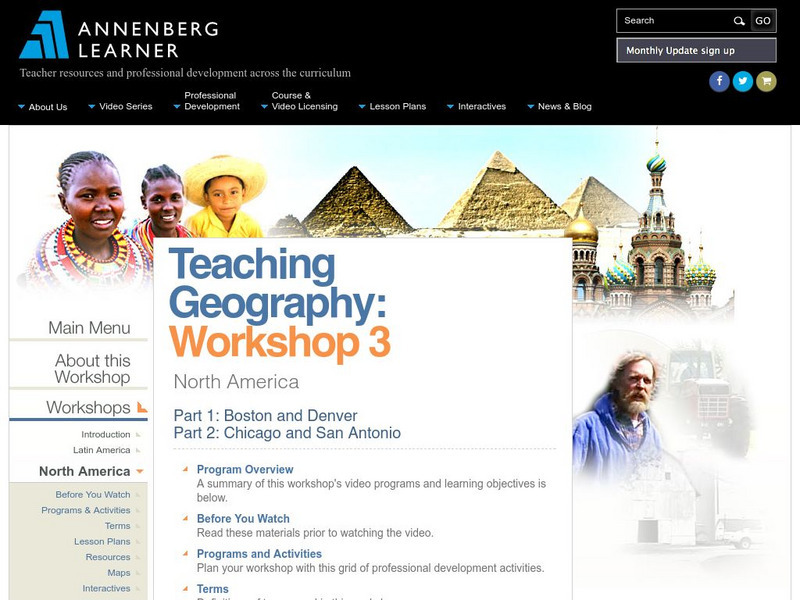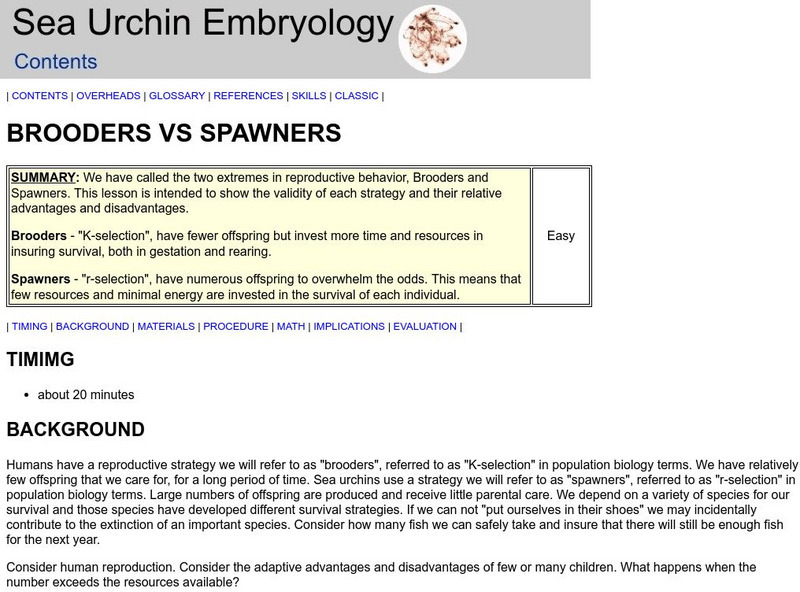Hi, what do you want to do?
Curated OER
Solid Waste
Students examine how to use their vocabulary, writing skills, and creative thinking to address environmental concerns in this unit. They write messages to using creative writing to address the issues of solid waste and recycling.
Curated OER
Comparing Cities
Young scholars research the characteristics of cities in two different geographical areas. Using the internet, they take notes on the information they collect and record their observations on the two cities. They discover how the...
Curated OER
A Walk in the Woods
Young scholars observe an environment, ask questions about what they observe. and design experiments to answer one question they came up with in this upper-level High School or college lesson. The lesson requires an outdoor exploration...
Curated OER
Surveying an Environment / Ecosystem
Students visit a local ecosystem to survey the plants and animals present and identify interactions between organisms. They identify interactions that occur between living organisms and their ecosystem and present their ecosystem to the...
Curated OER
Trappers Then and Now
Students study how trapping in the Illinois Territory in the 1800's effected the beaver population in the state. They compare methods, rules and regulations of the 1800s to those of today. In groups, they research a variety of...
Curated OER
Veterans Day Remembered
Sixth graders gather information about Veterans and create a PowerPoint. In this Veterans remembered instructional activity, 6th graders interview a veteran and research on the computer to create a five slide PowerPoint.
Curated OER
Pausing to Breathe
Students identify and summarize the critical aspects of each of the four topics on air pollution. They present these critical components in an interesting and creative manner to class members.
Curated OER
Earthworks
Seventh graders explore watersheds and take samples and analyze the data from a watershed in the area.
Curated OER
It's in the Garbage
Students analyze how studying garbage relates to methods of archaeology. They examine garbage to determine things about their culture and relate that to prehistoric peoples.
Curated OER
The Market for Moving People to America, 1610-1775
Students examine the markets that brought people to America. They identify the role of the immigrants in creating this country. They also analyze data to gather information about the time period.
Curated OER
Democracy, A Basic Element In Our Society
Students investigate the concept of freedom with the context of the First Amendment. They research and take notes looking for the connections between democracy and freedom. They complete a writing assessment that includes naming all of...
Curated OER
The Berlin Wall
Students enter the classroom and observe a wall that is set up with desks, bookshelves, or anything else available. to create a barrier that they cannot cross during the class. The class then is divided into East and West Berlin with the...
Curated OER
Native American Poetry
Fourth graders locate the poetry section of the LMC. They produce a hand written transparency based on the poem Hiawatha by Henry Wadsworth Longfellow. Students illustrate a poem from their poetry section. It is a mystery to them what...
Curated OER
Feedback and Flowcharts
Sixth graders explain what a negative feedback system is and they distinguish it from a positive feedback system. They describe examples of how negative feedback is used in both nature and technology. , Students define homeostasis, and...
Curated OER
Underwater Habitats
Pupils make a hydrophone and attach it to their Sea Perch ROVs. They use the hydrophones in conjunction with the underwater cameras on the ROVs to explore their local aquatic environments.
Curated OER
Home on the Range
Students use maps and mathematics to determine the appropriate panther population in a given area. In this Florida ecology instructional activity, students research the area requirements of male and female panther and use a map to help...
Annenberg Foundation
Annenberg Learner: Teaching Geography: North America
Media-rich site that explores North America. The first part of this workshop focuses on the general human behavior in urban settings looking for and interpreting those patterns. The second portion draws attention to urban issues such as...
University of Illinois
University of Illinois: Illinois State Water Survey: Nitrogen Cycle: Human Impact on the Nitrogen Cycle
An overview of the impact of human activities on the environment and how those actions effect the nitrogen cycle.
Trinity University
Trinity University: Inherited Traits Versus Learned Behaviors [4Th Grade]
In this extremely detailed unit, students will learn the about innate and learned characteristics in animals and humans through a series of teacher and student-led discussions, readings, reflections, learning activities, and...
Science Buddies
Science Buddies: Multitasking: Brain Drain or Boost in Efficiency?
Think it's a good idea to plug into iTunes, surf the Web, or watch TV while doing homework or trying to read? Many people do it and claim that jumping from one activity to another keeps their attention level up and even gives their brain...
Georgia Department of Education
Ga Virtual Learning: Sociology: Socialization
Sociology instructional unit on socialization. Students learn theories about human behavior and self development through audio, text, and instructional activities. Links to supplemental reading.
PBS
Idaho Public Television: Birds of Prey Facts
Dialogue for Kids, a program on Idaho Public Television, offers facts, information, and images of birds of prey. Learn what makes a bird a raptor, what raptors look like in the sky, threats that face these birds, and more! Classroom...
Georgia Department of Education
Ga Virtual Learning: Psychology: Biological Foundations
Virtual learning course on human biology and brain function and how it affects our behaviors. Extensive collection of engaging materials, assignments, and activities for review.
Stanford University
Stanford University: Brooders vs Spawners
A great explanation and hands-on activity to compare strategies of animal reproduction. Sea urchins and humans are compared.


























